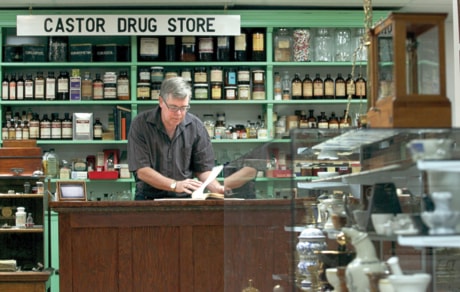There’s just something about Nuga Tone that strikes the fancy of retired pharmacist Mike Bain.
Billed as a “valuable health and body tonic” with the reassuring claim that it had the “high approval of Medical Science,” the little box contains a toxic wallop to take the breath away.
Bain chuckles when he reads out the 1920s-ish medicine’s three top ingredients: strychnine sulphate, arsenic trioxide and corrosive sublimate.
“Three of the most toxic things you can think of today are in that product,” he marvels. “But that was considered good medicine at that time.”
Nuga Tone, Dr. Chases’s Gin Pills for the Kidneys, Wampole’s Lime Water Tablets and Witch Hazel and Almond Cream (“A delightful toilet preparation”) are just a handful of the thousands of medicines, curatives, balms, oils, linaments, syrups, drops and creams that Bain plans to make the centrepiece of a new museum in Castor.
The collection will be housed in the town’s original 1921 McDermid Drugs pharmacy, which has been in his family since 1946 when his father Mike Bain Sr. began a 31-year career dispensing pills and medicines to ease the ailments of the farming community’s folk. Bain Jr. took over and put in his own 31 years behind the counter before retiring in 2008.
Since hanging up his white coat, Bain’s hobby of collecting all things pharmaceutical from yesteryear has blossomed into an ambitious plan to create a main street salute to the often long-forgotten cures to all that ails.
Over the last few months, Bain and his partner of five years, Wendy Anhorn, have spent, at times, 12-hour shifts scraping, planing, stripping and hammering to return the pharmacy, relegated as a storage space since 1988, to its former glory. Carpet, tiles and plywood gave way to the original fir flooring, which will be sanded, repaired and polished to its original sheen.
Bain already has a treasure trove of items from the original store, including four sections of shelving, a desk, old fountain pen showcases and a dispensing table that has been lovingly restored and still sports the cigarette burns left where his father’s ashtray once sat.
“We deliberately left some of this as the character of the time,” he said. “It would be unheard of now to smoke in a dispensary.”
Scales, a cash register, cork rollers to fit them into glass medicine bottles, and the wooden packing cases used to transport drugs by rail from Toronto to Castor are just a few of the gems that have survived in basements and storage areas until rescued by Bain over the last few years. Other items have come from antique stores, donations, auction sales and even the occasional eBay foray.
He credits a trip to Ireland several years ago with giving the pharmacy museum a boost. A relative pulled out an old black and white photo taken shortly after his father and uncle bought the building. Clear as day in the background were the shelves he had seen in his parents’ basement.
Those shelves, in a difficult-to-describe green hue, are the first thing you see in his basement “apothecary,” a well-organized but almost overwhelming gold mine of drugstore history from the turn of the century to the 1950s.
Besides the exhaustive collection of medicines and cures (the mercury-based Stillman’s Freckle Cream has to be seen to be believed) there are displays of all the other day-to-day products found on drugstore shelves more than a half-century ago. There are perfumes and makeup, direct from France, soaps and grooming products. And don’t forget the candy counter. Cherry chocolate blossoms from Lowney’s were yours for five cents; a licorice whistle, one cent.
Sometime next year, this labour of love will be transported to the restored main street pharmacy in time for the town’s centennial.
Help with the project has been coming from all directions. A family that purchased an old pharmacy in Standard provided all of the wood panels that had been stripped from the building years ago and lay in storage. (The same store produced an exquisite pharmacy cabinet, complete with the original imperfect glass, that he now owns). The half-wall panelling was painstakingly stripped and planed and will be refinished to a gleam.
“Neighbours of ours just brought us a load of headers and things that they had that we might be able to use.”
The spots where the old shelving stood are still visible in the floor and Bain plans to mark it out to position replacement shelves. When completed, he hopes he has created something special for the town.
Besides the pharmacies at Fort Edmonton and Calgary’s Heritage Park, not much pharmacy history has been preserved.
“There’s no other place I know of that has any signification pharmacy restoration or pharmacy history available. I guess it will be very unique to here. We’d like to make this into a little gem.”
The passage of time has not been kind to many smaller communities and Bain sees the potential to give Castor a little boost.
“I think it will be good for the town to have it. I certainly have tremendous community support.”
Castor already has a lot going for it, he said with undeniable pride. A three-storey wooden hospital dating to 1910 still stands, as does a grain elevator, one of only 19 in the province with historical designation.
The museum is top-notch and nearby sit four rail cars. “You can’t find four better-preserved rail cars anywhere.”
It’s a historical legacy that Bain is looking forward to enhancing.
pcowley@www.reddeeradvocate.com
